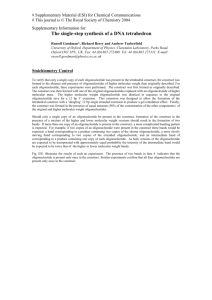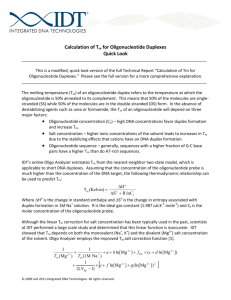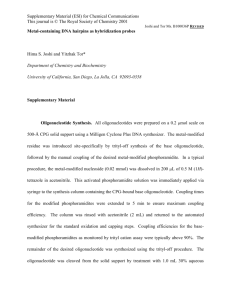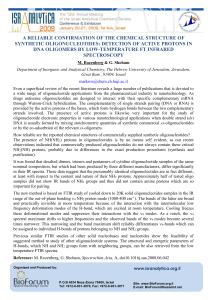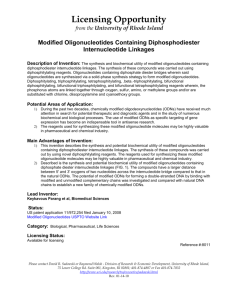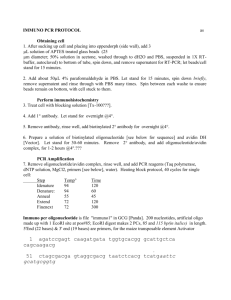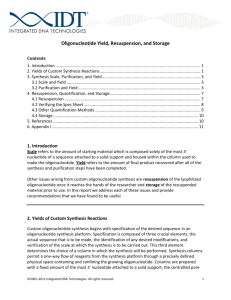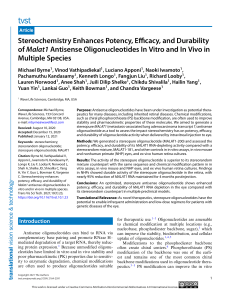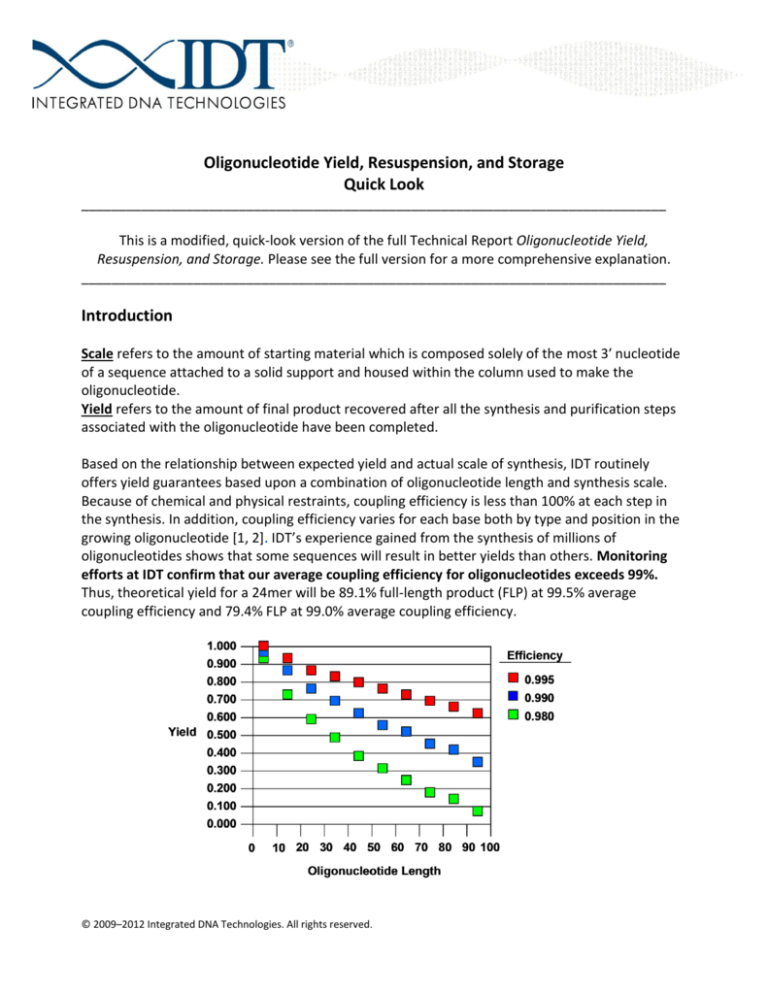
Oligonucleotide Yield, Resuspension, and Storage
Quick Look
______________________________________________________________________________
This is a modified, quick-look version of the full Technical Report Oligonucleotide Yield,
Resuspension, and Storage. Please see the full version for a more comprehensive explanation.
______________________________________________________________________________
Introduction
Scale refers to the amount of starting material which is composed solely of the most 3′ nucleotide
of a sequence attached to a solid support and housed within the column used to make the
oligonucleotide.
Yield refers to the amount of final product recovered after all the synthesis and purification steps
associated with the oligonucleotide have been completed.
Based on the relationship between expected yield and actual scale of synthesis, IDT routinely
offers yield guarantees based upon a combination of oligonucleotide length and synthesis scale.
Because of chemical and physical restraints, coupling efficiency is less than 100% at each step in
the synthesis. In addition, coupling efficiency varies for each base both by type and position in the
growing oligonucleotide [1, 2]. IDT’s experience gained from the synthesis of millions of
oligonucleotides shows that some sequences will result in better yields than others. Monitoring
efforts at IDT confirm that our average coupling efficiency for oligonucleotides exceeds 99%.
Thus, theoretical yield for a 24mer will be 89.1% full-length product (FLP) at 99.5% average
coupling efficiency and 79.4% FLP at 99.0% average coupling efficiency.
© 2009–2012 Integrated DNA Technologies. All rights reserved.
Synthesis of very long oligonucleotides (those greater than 60 bases) is problematic. Thus, IDT
does not offer any yield guarantees for oligonucleotides greater than 60 bases at our highest
synthesis scale and greater than 100 bases at any scale. In addition, as a general rule, IDT
recommends that any oligonucleotide longer than 40 bases should receive further purification. In
addition, for demanding applications such as site-directed mutagenesis, cloning, and gel-shift
protein-binding assays, additional purification is recommended even for oligonucleotides shorter
than 40 bases. Finally, in specific instances, IDT requires additional purification of an
oligonucleotide synthesis. Please note that additional purification will result in a decrease in final
oligonucleotide yield.
________________________________________________________________________________
Resuspension
Oligonucleotides are shipped in dry (lyophilized) form unless otherwise requested. Lyophilized
DNA is usually very easy to resuspend in an aqueous solution. However, not all oligonucleotides
dry identically and some can take more time to completely go into solution than others. In some
cases it is possible for the dried oligonucleotide to become dislodged from the tube during
shipping. Thus, it is very important to spin every oligonucleotide prior to opening the tube for
resuspension.
What to use:
1) TE buffer. We recommend using TE buffer because the buffer will maintain a constant pH. The
oligo should not be exposed to conditions that are either too acidic or too basic. IDT supplies a
nuclease-free IDTE buffer (10 mM Tris pH 8.0; 0.1 mM EDTA; pH 8.0). See the IDT Catalog for
ordering information.
2) Water. If using water for resuspension, be sure to use only nuclease-free water, pH 7.0 (HPLCgrade is preferable). DEPC water will harm oligonucleotides and water from a Millipore, or other
types of deionizing, system can be acidic with pH as low as 5.0.
How to resuspend oligos:
1) Spin down the tube before opening. The oligonucleotide pellet may become lodged in the lid;
spinning is important to insure it does not fall out when the lid is opened.
2) Decide on the final concentration. We recommend a 100 M concentration. This is an easy
concentration to make and is an easy concentration to dilute. This will be the stock concentration
which will be diluted for the working solution for each experiment.
All yield information is contained on the “spec sheet” for each oligonucleotide. This
contains the actual yield of the oligonucleotide synthesis in three forms: optical density (OD) units;
mass in milligrams (mg); and copy number in nanomoles (nm).
To make a 100 M concentration: Take the number of nmoles of oligo in the tube and
multiply that by 10. This number will be the number of L of buffer to add to get a 100 M
© 2009–2012 Integrated DNA Technologies. All rights reserved.
solution. For example, if you have 9 nmoles of oligo, add 90 L of buffer to make a 100 µM
solution.
Alternatively, dilution using mass units involves the OD units and weight of the oligo. A
20mer oligonucleotide primer with random base composition will have a molecular weight of
~6100 and a molar extinction coefficient of 196,900 L/mole-cm. 1 OD260 unit of this
oligonucleotide will therefore correspond to 31 g, or 5 nmoles, of DNA. Dissolving 500 g of DNA
(16 OD units) in 500 l of TE will yield a stock primer concentration of 1 g/L, or about a 160 M
solution. This converts to 160 picomoles of oligonucleotide per L.
An oligonucleotide can be stored at any concentration. However, concentrations lower
than 1 M may change over time as some of the oligo may be absorbed into the plastic of the
tube. In addition, a 5–10 mM solution is generally the highest concentration at which an oligo will
go into solution.
3) For hard to suspend oligos, heat at 55o C for 1–5 minutes, then thoroughly vortex. If this does
not work, the tube might have Trityl (flakey appearance) or CPG (a pellet at bottom of tube).
Neither of these should affect the performance of the oligo, and both can be removed with a
Sephadex G50 column, or by removing the supernatant.
________________________________________________________________________________
Storage
Store resuspended oligonucleotides as several small aliquots at –20°C.
________________________________________________________________________________
References
1.
2.
Temsamani J, Kubert M, and Agrawal S. (1995) Sequence identity of the n-1 product of a
synthetic oligonucleotide. Nucleic Acids Res, 23(11): 18411844.
Hecker KH and Rill RL. (1998) Error analysis of chemically synthesized polynucleotides.
Biotechniques, 24(2): 256260.
© 2009–2012 Integrated DNA Technologies. All rights reserved.

